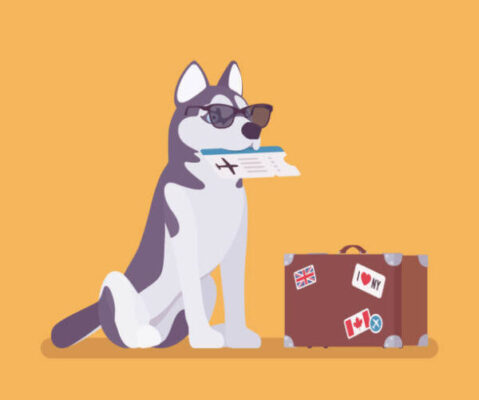Are you planning on flying with dog to Europe? According to the European Pet Food Industry Federation, there are over 80 million pet dogs in Europe. With so many pet owners looking to travel with their furry friends, it’s important to know the ins and outs of flying with a dog to Europe.
In this comprehensive guide, we’ll cover everything you need to know about traveling with your dog to Europe, the documentation and requirements, airline policies, and tips for traveling with a service dog. Whether you’re planning a vacation with your beloved pet, traveling with service dog to Europe or need to travel with dog to Europe, this guide has got you covered.
This article will cover a variety of topics :
- Rules and Regulations
- Choosing the Right Airline and Flight
- Preparing for the Flight
- During the Flight
- Arrival and Customs
Rules and Regulations


Here’s what you need to know about flying with a dog to Europe:
Necessary Document to Travel
First and foremost, it’s essential to ensure that your dog has all of the necessary documents, vaccinations, and microchipping requirements in order to be allowed into the EU. This includes a pet passport, proof of a rabies vaccination, and a microchip that meets EU regulations. Some countries may also require additional vaccinations or tests, so be sure to check with your veterinarian and the destination country’s embassy or consulate.
Alternative options to bring your dog to Europe
Flying with dog to Europe can be challenging. If you’re unable or unwilling to fly with your dog to Europe, there are alternative options such as shipping your dog through a pet transport company or taking a pet-friendly cruise. However, it’s important to research these options thoroughly and ensure that your dog will be safe and comfortable throughout the journey.
Travel with your Cats
Flying to Europe with a cat is also possible. For those traveling with a cat to Europe, many of the same rules and regulations apply, including the need for a pet passport and microchip. However, there are some differences in terms of required vaccinations and documentation, so be sure to consult with your veterinarian and the destination country’s embassy or consulate.
Choosing the Right Airline and Flight


When it comes to flying with a dog to Europe, choosing the right airline and flight can make all the difference in ensuring a safe and comfortable journey for both you and your furry friend. In fact, according to the Department of Transportation, over 2 million pets and other live animals are transported by air every year. Here are some factors to consider when selecting an airline for pet travel to Europe from USA:
Choose a Pet-friendly Airline
First and foremost, it’s important to choose a pet-friendly airline that allows dogs in the cabin or cargo hold. Flying to Europe with dog in Cabin is a good option. That makes flying with dog to Europe possible. Some airlines may have breed or size restrictions, so be sure to check the airline’s policies in advance.
Check Airline’s regulations
One of the most important factors to consider is the type of flight and associated regulations. For example, some airlines may not allow pets on certain types of flights, such as international or long-haul flights. Additionally, there may be specific regulations regarding the size and type of crate or carrier that can be used for pet travel.
Airline’s Track record
It’s also important to research the airline’s track record when it comes to pet travel, including any incidents or issues that have occurred in the past. Reading reviews from other pet owners who have flown with the airline can be a helpful way to gauge the airline’s pet-friendliness and overall safety.
EU Pet Passport


You also have to check out new travel regulations for humans as well. From 2025, nationals of 58 countries worldwide enjoying visa-free access to the EU will be required to have valid ETIAS authorizations upon arrival at the border. Therefore, it is going to change a lot of things.
Preparing for the Flight
Preparing your dog for a long-haul flight can be a daunting task, especially if you’re moving to Europe with a dog. However, with the right preparation and planning, you can help ensure that your furry friend is comfortable and safe throughout the journey.
Specific guidelines of Airline
it’s important to invest in an airline-approved pet carrier that provides ample space and ventilation for your dog. Many airlines have specific guidelines regarding the size and type of carrier that can be used, so be sure to check with your airline before making a purchase. It’s also a good idea to crate train your dog well in advance of the flight to help them feel more comfortable and secure in their carrier.
Feed and Exercise Dog
In the days leading up to the flight, it’s important to feed and exercise your dog according to its normal routine. it’s a good idea to reduce the amount of food and water your dog consumes in the hours leading up to the flight to help prevent accidents and discomfort during travel.
Check Paperwork and Vaccination List
It’s important to make sure that your dog’s paperwork and vaccinations are up-to-date and in order. If you’re moving to Europe with a dog, you may also need to consider alternative travel options. For example, you can travel to Europe by boat with dog. Some of the best places to travel with a dog in Europe can be explored that way. Regardless of the method of travel, taking the time to properly prepare your dog for the journey can help ensure a safe and stress-free experience for both you and your furry friend.
During the Flight


Follow the Airline’s Regulations
It’s also important to follow any airline regulations regarding the handling and transport of pets. By taking these steps, you can help ensure a safe and comfortable journey for your furry friend.
As mentioned above, there will be new ETIAS travel regulations from 2025. Completing the ETIAS application will take you no more than 15 minutes, and once submitted, you’ll get your ETIAS application feedback within hours. Although the ETIAS application will have estimated 95% of approval rate, still, not everyone will get ETIAS authorization.
Arrival and Customs
After a long flight to Europe with your dog, you’ll need to navigate the arrival procedures and customs regulations. This may include presenting your dog’s necessary documents and certificates, such as a valid EU pet passport or health certificate.
Research specific customs Regulations
It’s important to research any specific customs regulations for the country you’re traveling to, as some may have additional requirements for bringing pets. During this time, it’s also important to manage your dog’s needs and comfort, such as providing them with food, water, and regular bathroom breaks. By preparing in advance and following the necessary procedures, you can ensure a smooth arrival for both you and your furry friend.
In conclusion, flying with your dog to Europe requires careful planning and preparation to ensure a safe and comfortable journey for your furry friend. This may include obtaining the necessary documents and vaccinations, selecting a pet-friendly airline, and preparing your dog for the flight. It’s also important to manage your dog’s needs and comfort during the journey, and to navigate the arrival procedures and customs regulations upon arrival. By following these key points and seeking advice from your veterinarian or a pet travel specialist, you can help ensure a successful and enjoyable trip for both you and your dog.
